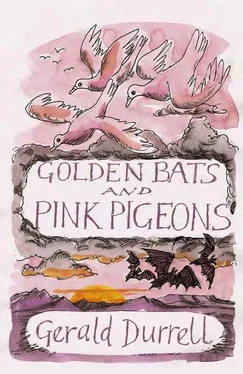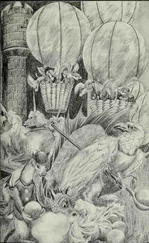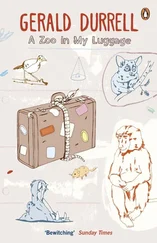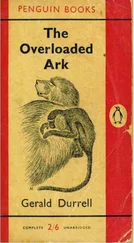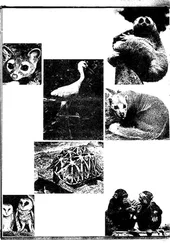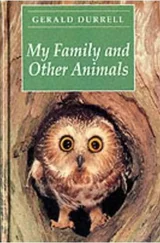Gerald Durrell - Golden Bats and Pink Pigeons
Здесь есть возможность читать онлайн «Gerald Durrell - Golden Bats and Pink Pigeons» весь текст электронной книги совершенно бесплатно (целиком полную версию без сокращений). В некоторых случаях можно слушать аудио, скачать через торрент в формате fb2 и присутствует краткое содержание. Жанр: Природа и животные, на английском языке. Описание произведения, (предисловие) а так же отзывы посетителей доступны на портале библиотеки ЛибКат.
- Название:Golden Bats and Pink Pigeons
- Автор:
- Жанр:
- Год:неизвестен
- ISBN:нет данных
- Рейтинг книги:4 / 5. Голосов: 1
-
Избранное:Добавить в избранное
- Отзывы:
-
Ваша оценка:
- 80
- 1
- 2
- 3
- 4
- 5
Golden Bats and Pink Pigeons: краткое содержание, описание и аннотация
Предлагаем к чтению аннотацию, описание, краткое содержание или предисловие (зависит от того, что написал сам автор книги «Golden Bats and Pink Pigeons»). Если вы не нашли необходимую информацию о книге — напишите в комментариях, мы постараемся отыскать её.
Golden Bats and Pink Pigeons — читать онлайн бесплатно полную книгу (весь текст) целиком
Ниже представлен текст книги, разбитый по страницам. Система сохранения места последней прочитанной страницы, позволяет с удобством читать онлайн бесплатно книгу «Golden Bats and Pink Pigeons», без необходимости каждый раз заново искать на чём Вы остановились. Поставьте закладку, и сможете в любой момент перейти на страницу, на которой закончили чтение.
Интервал:
Закладка:
Zooxanthelae. These minute creatures obtain their sustenance from the food the clam sucks in, and in payment they give the clam an additional supply of oxygen. It is rather like paying for your daily bread with air, a thing most of us would like to do.
I shifted my vantage point to the other side of the rock, making sure of the whereabouts of the Scorpion fish, and came upon yet another symbiotic relationship. There was a small shoal of various multi-coloured fish, which included a Box fish and three canary-yellow Surgeon fish. The Box fish was quite incredible. He was only three inches long, vivid orange with black polka-dots all over him; but it was not the colouration so much as the bizarre shape of the creature which amazed me, for the whole body is like a square box of bone and through holes in this protrude the creature’s fins, vent, eyes and mouth. This means that the tail has to wave around like the propeller of an outboard engine. This mode of locomotion, coupled with the fish’s big, round, perpetually surprising-looking pop-eyes, its square shape and polka-dot suiting, combine to make it one of the most curious inhabitants of the reef.
The Surgeon fish were quite different. Their yellow bodies were roughly moon-shaped, they had high domed foreheads and their mouths protruded, almost like the snout of a pig. They get their name from the two sharp, scalpel-like knives set just behind the tail. These dangerous weapons can fold back like the blade of a pocket knife into a hidden groove.
But, fascinating though these two species of fish were, it was what was happening to them that was so curious. The two Surgeon fish were close to the rock, hanging in a trance-like state while the Box fish puttered to and fro like some weird, orange boat, occasionally coming to a standstill. Among them darted three lithe little fish, small gobies with bright Prussian- blue and sky-blue markings. They were cleaner fish and they worked assiduously on their three customers, zooming in to suck the parasites off their skin and then, as it were, standing back to admire their handiwork before dashing in again, rather like effeminate hairdressers admiring the creation of a new hairstyle. Later on, on the big main reef, I sometimes saw queues of fish waiting their turn at the barber’s shop, where the little blue barbers worked in a frenzy to keep up with their customers.
So captivated had I become by all I had seen, for every inch of what we came affectionately to call ‘St Paul’s’ was covered with tiny anemones, sea fans, feather worms, shrimps, crabs and a host of other things, that I discovered I had spent over an hour suspended in one spot and even then, had been unable to take it all in. Here, on this one rock, was a myriad of life which would require a naturalist to spend a dozen lifetimes even to start to unravel it. What, I wondered, as I swam slowly back to breakfast, was the reef going to be like? I was soon to know. It was overwhelming.
As soon as we could, I made arrangements for a boat and a boatman to come early each morning so that we would be able to spend a couple of hours on the reef without it interfering with our other activities. So, two days later, the boat puttered its way across the silk-smooth lagoon and ground, with a faint sigh, in the sand just outside our bedrooms. Abel entered our lives. He was a slender young Creole with extensive side whiskers and a moustache, a wide, engaging African grin and a curiously husky, high-pitched voice. He had been stricken with polio at 12 years old when Mauritius had a virulent epidemic of this frightful disease but though this had partially withered his right arm and leg, he was still agile in his boat and could swim and dive like a fish. Like most countrymen and fishermen, he was extraordinarily knowledgeable about the sea life and where to find it, but his learning was mixed up with much inaccurate folk lore. Nevertheless, his knowledge of the reef was superb and he could take you to see anything you asked him, from octopus to oysters; from long, pointed shells like unicorns’ horns, spattered with blood-red spots, to coral forests that defy description.
The first day we went out with him, he explained that the reef was divided roughly into five sections. There was the deep water reef where you swam outside the lagoon; there was the sandy area with only a scattering of rocks (like ‘St Paul’s’) along the shoreline; and then there were the three separate sections of coral bed. In each one you saw something different. So, the first day he took us out to what we called the ‘Stags’ Graveyard’ or ‘Landseer’s Corner’.
First, we crossed the sandy stretch. Lying on the tiny deck in the bows, with the early morning sun warming my back, I could gaze down into the clear water. First there were a host of sea slugs and the strange hosepipe-like Sinucta, then literally thousands of the big, red starfish, lying ghost-like, just buried under the sand, and interspersed with these on top of the sand, a great many cushion starfish. These are fat and round, like a pudding, and the arms are short and blunt so that the edges look almost scalloped. They are a yellowy-orange in colour and studded all over with slimy, jet-black, conical spikes like straight rose thorns.
Gradually we passed over more and more crops of coral and then the sand disappeared and we were gliding over a multi-coloured Persian carpet of weed and coral, and schools of bright fish shot from under our bows. Reaching the spot he had chosen, Abel turned off his engine and tossed the anchor, a huge lump of iron with a ring on it, over the side. We came to a standstill in some six foot of water, so clear it would have made vodka look murky. Hastily, we donned our masks and slipped over the side of the boat into a world so enchanted that it surpassed all poetic descriptions of fairy land one had ever read or imagined. One’s first impression was of a blaze of colour, gold, purple, green, orange, red, and every conceivable shade in between. Once you had got over your astonishment at this polychromatic world, it was the shapes that captured your imagination. In this particular section, the predominant coral was Stag’s horn, exactly like a great graveyard of all the finest Victorian deer trophies, decked out in white and electric blue. Some were only a few feet high, but here and there the coral formed huge shapes like white and blue Christmas trees, through whose branches drifted flocks of small, multi-coloured fish, as parakeets drift and swoop through trees in a tropical forest. Interspersed with these forests of Stag’s horn were the Brain corals, some as big as plum pudding, others the size of an armchair, and interspersed between these, a bewildering array of delicate sea fans, soft corals and weeds.
If their habitat was breathtaking and confusing by its diverse colouration and shape, then so were the inhabitants. I was interested in a certain similarity to the land. The small, multi-coloured fish flew through the forests of Stag’s horn like flocks of birds while below, the black and white Damsel fish in schools moved like herds of zebra among the sea fans. From the crevices in the coral, another dark chocolate and pink-coloured fish with large fins and a sulky, pouting mouth came out to threaten you when you invaded its territory, spreading its fins as an elephant spreads its ears when it charges. Then there were smouldering orange and black fish, like tigers, prowling in the shadowy depths of coral and quick-moving flocks of slender orange-brown fish like gazelles or antelope. Here in crevices, like sleeping porcupines, lay sea urchins, vivid blue and jade-green, and others of palest lavender.
I swam through this enchanted world, drugged by the colours and bizarre shapes, until I rounded a coppice of Stag’s horn with vivid blue tips to each spike, and came on a small, sandy clearing, with sea slugs and purple and black sea urchins littering the bottom. Over them lay in the water perhaps fifty or so small fish which were to become my favourites. They were about four inches long and at first glance, because of their position, they seemed to be all pale leaf-green, the tender and beautiful green of lime trees with their buds just about to burst but with an iridescence as if each fish had been varnished. As I swam closer, however, I discovered the most spectacular thing about them. Slightly wary of my proximity, they swam past me. As I followed them, they turned, in one blink of the eye, from their delicate leaf-green to the most beautiful blue, the blue they used to use in medieval paintings for the robes of the Virgin Mary, a Madonna blue, with the same iridescence.
Читать дальшеИнтервал:
Закладка:
Похожие книги на «Golden Bats and Pink Pigeons»
Представляем Вашему вниманию похожие книги на «Golden Bats and Pink Pigeons» списком для выбора. Мы отобрали схожую по названию и смыслу литературу в надежде предоставить читателям больше вариантов отыскать новые, интересные, ещё непрочитанные произведения.
Обсуждение, отзывы о книге «Golden Bats and Pink Pigeons» и просто собственные мнения читателей. Оставьте ваши комментарии, напишите, что Вы думаете о произведении, его смысле или главных героях. Укажите что конкретно понравилось, а что нет, и почему Вы так считаете.
